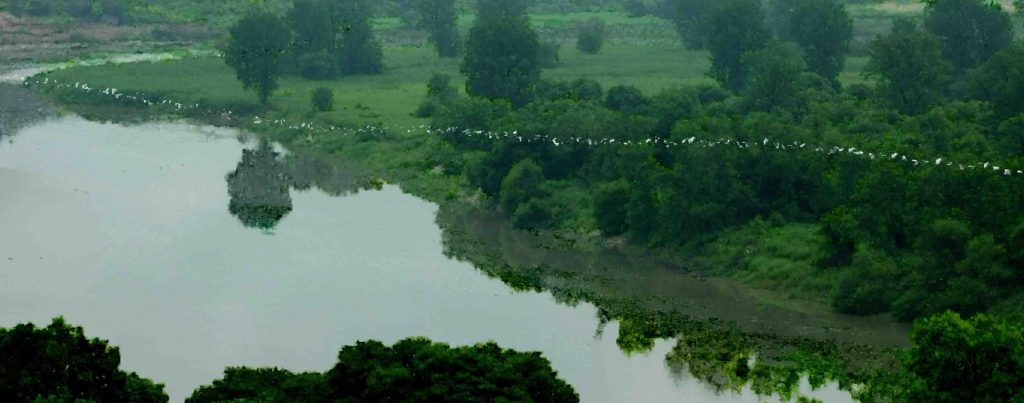At Manarat Al Saadiyat in Abu Dhabi, a landmark exhibition of Korean contemporary art – born from a partnership between the Abu Dhabi Music & Arts Foundation and the Seoul Museum of Art – traces how meaning mutates and resonates across transnational contexts.
At Manarat Al Saadiyat in Abu Dhabi, industrial pipes lean against the wall – sliced open, inverted and glistening under the light. Made using materials found locally, Goeun Choi’s Gloria (2023) recalls an earlier iteration of the work that the artist exhibited in Seoul. The formal echo across two regions gestures toward the shared infrastructures that shape global urban life, speaking to the transnational sensibilities of the exhibition, Layered Medium: We Are in Open Circuits.
Co-curated by Maya El Khalil of the Abu Dhabi Music & Arts Foundation and Kyung-hwan Yeo of the Seoul Museum of Art, the show features 48 works by 28 Korean artists from the 1960s to today – the largest exhibition of Korean contemporary art to take place in the Gulf to date.
However, Layered Medium is not, as one might expect, merely an introduction to “what Korean contemporary art is”. Instead, it situates Korea as a node in a larger transnational circuit – one in which the UAE is also embedded – where phenomena such as urban acceleration and ecological precarity manifest in distinct yet resonant ways. In doing so, the show creates space for an encounter between subjects who inhabit what art historian Terry Smith calls “contemporaneity”: multiple ways of being in time, at the same time as others, but also at earlier and future times.

The exhibition opens with works by Nam June Paik and other pioneers of Korean media art, accompanied by a vitrine of archival materials tracing Korea’s sociopolitical shifts since the 1960s. Facing the entrance is Paik’s Self-Portrait Dharma Wheel (1988), a sculpture consisting of five CRT monitors mounted on wheels, flashing images of John Cage and the Buddha that continuously morph into one another. Paik is a particularly apt choice to begin the exhibition, not only because of the artist’s legacy on the avant-garde contemporary art scene but also because his life defies national boundaries; although born in Korea, the he spent much of his life moving through Japan, Germany and the United States. His inclusion hints at the exhibition’s broader premise: that Korean contemporary art, like Paik himself, resists neat categorisation and unfolds across a multitude of cultural and geographic terrains.
The gesture toward chronology implied by the archival vitrine soon gives way to thematically organised sections that explore bodies, society, and space as mediums. As fundamental registers through which humans experience the world, these categories function as accessible coordinates for visitors to feel their way through the exhibition. The first section, focused on the body, spans an early painting by Lee Kun-Yong to recent works that incorporate AI, generative coding and sound to expand the notion and senses of the body, such as SunJeong Hwang’s Telluric Memories: Warm Woven Clicks, and Entangled Radiant (2024).
A standout in this section is Moka Lee’s Surface Tension 05 (2023), a portrait of a young female painted from an image circulating on social media. Arresting in its emotional opacity – contrasted by a luminous, carefully built-up surface – the work highlights the performative nature of seemingly casual images shared in monthly Instagram dumps. At a time when selfhood is negotiated through digitally curated images across the world, Lee’s work gains a particular poignance.

Taken together, these explorations of the body set the stage for a shift in focus from the individual to the collective. The following section interrogates society, articulated in the curatorial text as “social worlds [composed of] complex processes of translation and historical interpretation” as a medium. The most powerful works are those that approach Korean history and political tension through an ambiguity that allows for generative mis/translation. Sojung Jun’s Green Screen (2021), which captures the heavily policed Demilitarized Zone (DMZ) that divides the Korean peninsula into North and South, bears specific connotations in its home context. However, shown in Abu Dhabi, the lush greenery – interrupted by flickering RGB pixels that hint at its status as a literal ‘green screen’ – the work registers differently. Here, where palm trees and manicured foliage are mobilised to construct pleasing urban landscapes, the piece might evoke thoughts on green desire and environmental manipulation. Through this mis/reading, viewers are prompted to reflect on their own local contexts, even as they remain aware of the work’s culturally specific resonance elsewhere.
The final section, examining space as a medium, most forcefully intersects with local realities in the UAE and wider Gulf region. Ayoung Kim’s Delivery Dancer’s Sphere and Delivery Dancer Simulation (2022) presents a speculative world in which delivery drivers race through algorithm-driven routes in a virtual space, optimising movement for maximum efficiency. The piece acquires renewed urgency in the Gulf, as it places delivery workers – who form part of a hyper-visible yet structurally invisible labouring class here – as subjects, asking viewers to consider how urban time and movement are unevenly experienced and to consider their own positionalities within the circuits of movement and extraction that define contemporary urban life.
Layered Medium is an exercise – and a successful one – in post-Western transnational exhibition-making. It avoids flattening Korean contemporary art into a singular, well-packaged narrative, instead allowing for nuanced meanings to emerge. Staged in Abu Dhabi, a city negotiating its own global image and temporal entanglements, the show offers a compelling model for how contemporary art can foster meaning across difference without requiring resolution.



